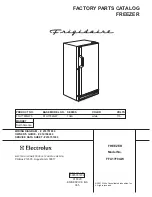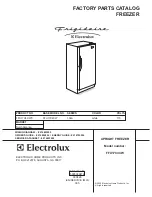
13
5. Cleaning and Maintenance
Cleaning
Disconnect the appliance from the power supply
before cleaning.
To maintain a high performance level, occasionally clean the
condenser coils at the back of the appliance.
Defrost the appliance regularly. A build up of thick ice
decreases the efficiency of the appliance. You should defrost
whenever the frost reaches 5 mm thickness.
To keep internal odours to a minimum it is best to periodically
clean the compartment.
Clean the interior using warm water and bicarbonate of soda
with a soft cloth. Make sure that the interior is then dried
carefully with a suitable cloth.
Do not use harsh abrasives, or aggressive cleaners
as these can damage the interior of the appliance.
Shelves and other accessories can be cleaned in the sink
using liquid dishwashing liquid and warm water. Make sure all
soap is rinsed off and all parts are dry before replacing them
inside the appliance.
Do not clean them in a dishwasher.
Always keep the door seals clean. Clean the door gasket with
warm water or a neutral detergent that leaves no residue. A
tight-sealing door gasket is critical to the efficiency of your
appliance.
Do not spray or rinse the freezer with water or
other liquids. this could harm the electrical parts.
Use a dry cloth when cleaning near the electrical
parts.
Do not clean the freezer with a stiff or wire brush.
Do not use an organic solvent such as detergent,
petrol, lacquer, thinners, acetone or acid.
to prevent your skin sticking to cold steel parts,
make sure your hands are not wet when touching
the parts.
Defrosting
The frost in the freezer compartment should be removed
periodically. Use a plastic scraper to keep down the amount
of frost that builds up.
IMPortant:
The freezer should be defrosted at least twice
a year. The number of times that you need to defrost it will
depend on the setting of your thermostat and how much
food you freeze and store in the freezer.
The day before you defrost, turn the thermostat dial to
position
[4]
. This will make sure that the food contained in
the freezer is frozen properly.
While defrosting the appliance, remove the food from the
freezer, wrap it in several layers of paper and store it in a cool
place. The temperature rise in foods will shorten its storage
life, so the food should be used within a relatively short time.
Do not place food back in the freezer once it has
started to thaw.
Set the thermostat knob to position
[0]
and disconnect the
appliance from your mains supply.
Leave the door to the freezer open. You can place a bowl
of warm water inside the freezer to speed up the defrost
process.
Use a sponge to mop up the defrost water that will run into
the bottom of the freezer.
IMPortant:
You should place some old towels on the
flooring that is immediately in front of the appliance. In
case any defrost water comes out of the freezer and onto
the floor.
Once all the ice has melted, thoroughly dry the inside of the
freezer.
IMPortant:
If the inside of the freezer is not dry, then
there will be an immediate build-up of ice when the
appliance is switched back on.
With dry hands, reconnect the appliance to the mains supply.
Set the thermostat knob to position
[4]
for 24-hours, before
returning it to the normal setting of between
[2]
and
[3]
.
Do not attempt to freeze fresh food inside the
freezer until after the 24-hours.
Do not use sharp metal objects to remove the ice
on the freezer, as this could cause damage to the
refrigerant system.
Do not use mechanical devices (such as hair dryers)
to accelerate the defrosting process.
When Not in Use
If you are not using the appliance for an extended length
of time, it is recommended that you switch off the electrical
supply, empty any food out, clean the inside of the appliance
and leave the door ajar.
This will save energy, and also prevent a build up of stale
odours inside.
Содержание U110120 - 01A
Страница 19: ...17...






































